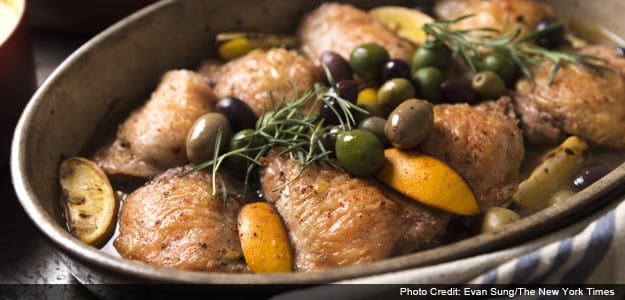A good cook needs an assortment of chicken recipes up his or her sleeve. It's fair to say most carnivores like chicken, but even chicken fans prefer a bit of variety, a break from the familiar roasted, fried, grilled.
Braising chicken is a technique to master. The simple process of browning the meat, then adding liquid and gently simmering, ensures tenderness and succulence.
Most people I know agree the thigh is the choicest part of the bird under most circumstances. I find chicken thighs make the best braises, and I recommend using skin-on bone-in thighs for the best flavor.
(In these days of skinless boneless everything and fear of fat, these unadulterated thighs are scarcer than before, but persevere; they can be found.)
One of the best chicken braises I know uses a broadly Mediterranean approach. The classic combination of chicken with lemon and olives is found throughout the region, but a minor tweaking of the basic recipe is all it takes to give this braise a regional accent.
The example given here is Italianate: rosemary, garlic, fennel seed and red pepper. Marinate the thighs, surround them with lemon wedges, and brown them in the oven. Add a handful of green and black olives and a ladleful of chicken broth. Simmer a bit. The result: earthy, herbaceous, lemony. Serve with polenta.
To give the same dish a more Provenal profile, use thyme sprigs rather than rosemary and choose oil-cured black or tiny nicoise olives. Serve with potatoes or egg noodles. For a North African feel, use large green olives and add toasted ground cumin seeds and hot paprika. Serve with flatbread or couscous.
As for lemons, any kind may be used. Meyer lemons are nice, since they are sweeter than others and the soft skin is mild enough to eat. But ordinary Eureka lemons are fine, thinly sliced, as are rinsed salt-preserved lemons cut in small cubes.
Of course, you should try to get the best chicken you can. Choose organic, free-range, heritage birds when possible. Even at $4 a pound, that's far less expensive than other prime cuts of meat, and you are more likely to get flavorful chicken if it is of noble provenance. Free-range birds generally have firmer muscles than cheaper factory style birds. If you have tasted chicken in other countries, you know that firm meat and flavor go hand in hand.
Once you are hooked on the chicken-lemon-olive theme, you'll find many more ways to practice it. Imagine, for instance, a chicken sandwich smeared with a garlicky chopped olive tapenade and a dab of bright lemony mayonnaise. You get the idea.
Braised Chicken With Lemon and Olives
Time: 1 3/4 hours
8 chicken thighs, skin-on and bone-in, about 3 1/2 pounds
Salt and pepper
1/2 teaspoon red pepper flakes
6 garlic cloves, minced
1/2 teaspoon crushed fennel seeds
1 tablespoon roughly chopped rosemary
1 tablespoon olive oil
2 Meyer lemons, cut in wedges
1 cup flavorful olives with pits, a mixture of black and green, about 1 pound
1 cup chicken broth
3 tablespoons chopped parsley
1. Pat chicken thighs dry with paper towels. Season well with salt and pepper and place in an earthenware baking dish in one layer, skin side up. Sprinkle with red pepper, garlic, fennel and rosemary and drizzle with olive oil. Rub seasoning into thighs on all sides. Tuck lemon wedges here and there. Let marinate for 15 minutes. Heat oven to 375 degrees.
2. Put baking dish in oven, uncovered, and roast until skin browns lightly, about 20 minutes. Scatter olives evenly over chicken and add broth. Cover tightly and bake for 1 hour, until meat is very tender when probed with a skewer.
3. Remove thighs and lemon wedges and arrange on a platter. Keep warm. Pour pan juices into a saucepan and quickly skim fat from surface. Over high heat, simmer rapidly until reduced by half. Spoon juices over chicken, sprinkle with parsley and serve.
Yield: 4 to 6 servings
And to Drink ...
The reflexive choice for this braised Mediterranean-style dish would be a lively dry white, from the Mediterranean or beyond. Cassis, a small appellation outside Marseille, would be ideal, but so would whites from Corsica, Sardinia and Santorini, or fianos and falanghinas from Campania. From beyond, perhaps village-level Chablis; dry, crisp sauvignon blancs; and, of course, Provencal roses. All these will echo the citrus and herbal elements of this dish. For contrast, consider vivacious reds, like gamays from the Loire or good Beaujolais-Villages. Try blends from the Languedoc, if they are not oaky, or lighter-bodied Sicilian reds like frappato or Cerasuolo di Vittoria. I would never say no to sherry; an orthodox approach calls for Amontillado, but for me, make it fino.
© 2015 New York Times News Service








